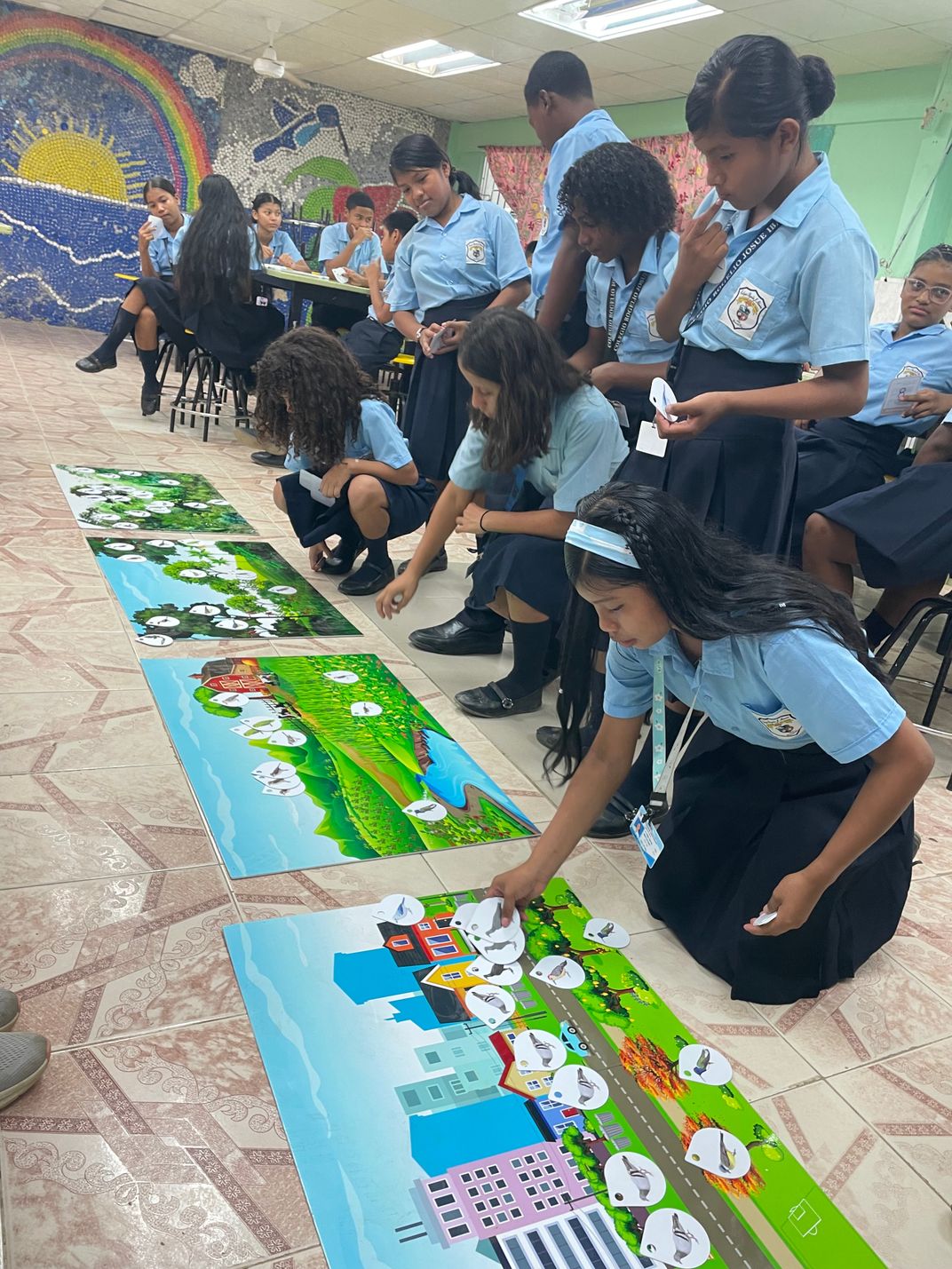Science on Wheels: The Little Bus That Could
Thanks to funding from the Adrienne Arsht Community-Based Resilience Solutions Initiative, the Q?Bus mobile classroom is back – and with a bigger impact than ever before.
/https://tf-cmsv2-smithsonianmag-media.s3.amazonaws.com/filer_public/f8/69/f86967b3-1cac-4293-8f06-2f47891fee89/img_6567.jpg)
In many science museums, collections are stored behind panes of glass or tucked away in dusty archives. A van covered in colorful hummingbirds, stingrays, and trees is bringing excitement and discovery back into science learning one classroom at a time.
A mobile science learning program called Q?Bus “gives students the simulation of being a scientist” according to Karina Hassell, Science Education Specialist at the Smithsonian Tropical Research Institute (STRI). Q?Bus, which started in 2018 with funding from a Smithsonian Youth Access Grant, was inspired by the Smithsonian National Museum of Natural History’s Q?rious (pronounced “curious”) exhibit, where students role-played as scientists and museum curators of natural history. STRI now has their own on-site exhibit, Q?rioso, located at Punta Culebra Nature Center in Amador Causeway in Panama City.
Karina, who designs the Q?Bus activities, explained that many students are unable to travel to the nation’s capital to see Q?rioso for themselves at Punta Culebra Nature Center. Q?Bus was designed to bring learning materials and guides to classrooms around the country: “It takes down the barrier of transportation for students,” she explained. Since 2020, due to lapses in funding and the pandemic, the Q?Bus has been in the garage. But with recent funding from the Adrienne Arsht Community-Based Resilience Solutions Initiative, Q?Bus hit the road to visit classrooms for the first time in four years.
Currently, the program offers three activities designed off ongoing research across the Smithsonian Institution. One of the activities, co-developed with the Rohr Reef Resilience Program, analyses the effects of climate change on coral reefs. The other activity focuses on water management and is from a collaboration with the Smithsonian Science Education Center’s Climate Resilience! guide.
The third activity, “Tras la Pista de las Aves” (on the trail of birds) tells the story of Panama’s migratory and resident birds and the different landscapes they encounter across cities, forests, and coffee farms. Based on research from the Smithsonian Bird Friendly Coffee and Cacao Program, Q?Bus guides teach students to use observations from their own lives to make connections between habitat quality, foraging needs, and ecosystem health.
Each detail of the program has been carefully considered. Students are presented with 3D models of birds so they can measure their beaks with calipers, just as scientists do in their field work. The models are even banded, a technique scientists use in research to track bird populations. The hands-on aspect engages even the most hesitant kids; “they just love using the calipers,” said Karina. The rest of the session includes activities and discussion comparing the biodiversity benefits of coffee farms with a variety of other trees and shrubs compared to coffee monocultures as well as the importance of nearby forests for migratory birds, two components of the Bird Friendly Program. Students are encouraged to use their own experiences and observations from their daily lives, too, to make predictions about how birds will use different landscapes.
Katherine Araúz Ponce, a doctoral student at the University of Georgia and researcher with the Bird Friendly Program, helped design Tras la Pista de las Aves. Katherine is from a family of coffee growers in Renacimiento District in the providence of Chiriquí and studies bird conservation on coffee landscapes. She was eager to explore how to share key concepts of the importance of birds and bird conservation in coffee growing landscapes. “As both a scientist and educator, I am deeply passionate about showing students, especially from the Renacimiento area, that cutting-edge science is happening right around them ... on the very coffee farms they know so well.”
For Q?Bus lead guide Adrian Lezcano, one of the highlights of each school visit is seeing how excited and curious the students are as the guides unload boxes for the day’s activities. During another lesson, students are encouraged to interact with specimens including shark jaws or mammal skulls and instruments like microscopes. Leslye Barría, the other lead guide, says that sometimes, the children she works with have never seen a microscope nor know what it’s used for. “But after fifteen minutes with the tool, we’re able to bring them closer to science,” she said. Karina reflected, “One of the highlights for me is seeing those students that typically don’t tend to do well in traditional science classes or who are regarded as ‘hard to handle’ shine doing science in a nontraditional way.”

When Q?Bus started in 2018, the initiative had a wide aim of reaching students from grade 1 – 10, but only in the three provinces closest to Panama City: Panamá, Colón, and Panamá Oeste. Now, the program has narrowed its focus to students grade 7 – 9 but has expanded its reach to include the provinces of Chiriquí, Veraguas, Coclé, Bocas del Toro, and the Ngäbe-Buglé Comarca. “We've had Q?Bus, Q?Boat, Q?Plane,” Adrian laughed. To reach schools in the Comarca, they piled into a four-by-four truck.
“Every day we go out, we learn something. There's always a kid who knows something that we don't, and there's always a teacher who's super happy because they never thought we'd visit,” said Leslye. Students in Katherine’s hometown of Renacimiento were even able to experience the lesson she helped create this year. “I hope these interactions help students walk away with a deeper understanding of how studying birds in coffee landscapes helps conserve wildlife, supports farmers, and improves livelihoods,” she shared. "I know, that as a child I would have find incredibly enjoyable this activity. Those moments can leave lasting impressions, sparking curiosity and a love for learning that lasts a lifetime.”

/https://tf-cmsv2-smithsonianmag-media.s3.amazonaws.com/filer_public/9d/d1/9dd1cfa9-8cc1-4e3c-89d7-b94e8e83cdd6/intro_to_classroom_at_cebg_zaida_z_nunez_la_chorrera_po.jpg)
/https://tf-cmsv2-smithsonianmag-media.s3.amazonaws.com/filer_public/8f/31/8f312ab4-8f7a-427d-8b60-52dc580d1f8b/1.jpg)
/https://tf-cmsv2-smithsonianmag-media.s3.amazonaws.com/filer_public/15/20/15207f5a-b0c2-4e7e-bff4-2ce84ede225c/2.jpg)

/https://tf-cmsv2-smithsonianmag-media.s3.amazonaws.com/filer_public/79/5f/795f616b-c912-466b-b2d9-cf84940a54b9/i3ugzuuy.jpeg)
/https://tf-cmsv2-smithsonianmag-media.s3.amazonaws.com/filer_public/99/cc/99cc8264-ccbc-4d97-af7b-dafe27e44919/2_animals_reforest.jpg)
